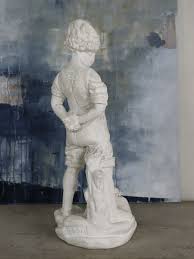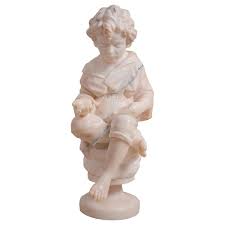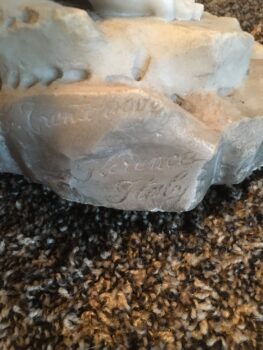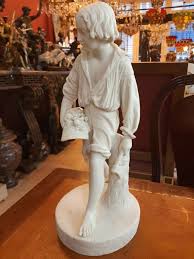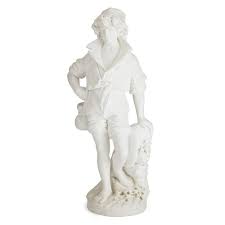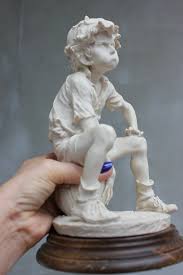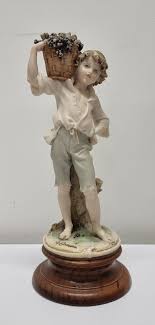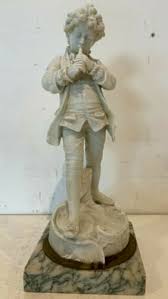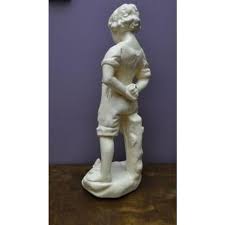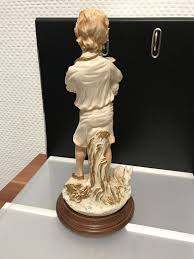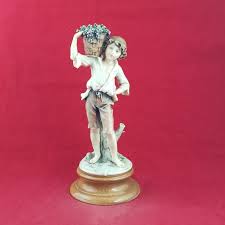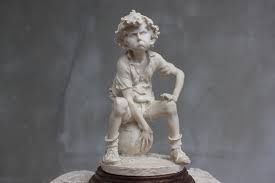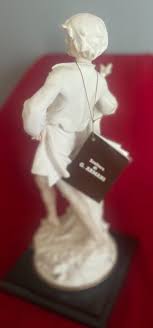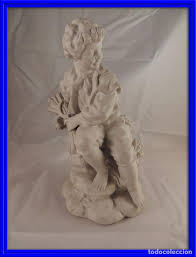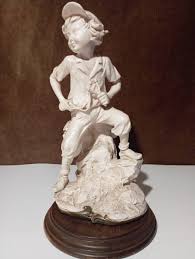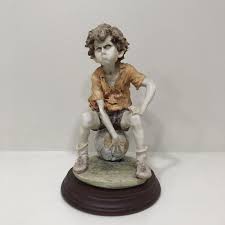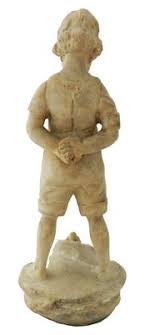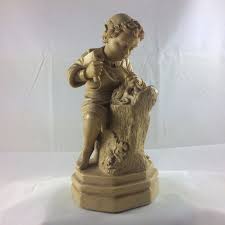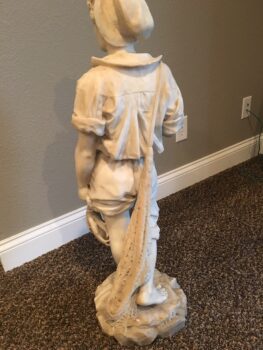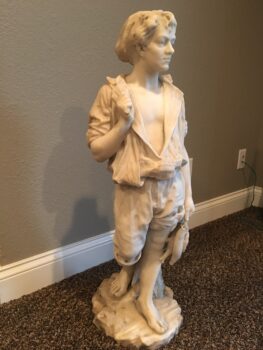An Original Hand Made marble statue from the Italian artist Gaetano Trentanove (February 21, 1858 – March 13, 1937) from circa early 20th Century Depicting a Body Sculpture of Young Italian Peasant
This report is designed to provide a professional appraisal of the specific item requested. It contains a detailed description and evaluation of the item, as well as information about the valuation method used. The value given in this appraisal report is applicable only to the item in question and should not be interpreted as a general valuation for any similar items. Values for similar items can vary significantly, ranging from one hundred to one hundred thousand US dollars, depending on subtle details.
This report is intended to give the owner an appraisal of their item’s value, whether it is furniture, china, glassware, or any other type of antique or collectible item. The information provided will help the owner to understand their piece and its value. Furthermore, it provides an appraisal value in US dollars, as well as advice on how to proceed if the owner wishes to sell the item. It should be noted that this report is not intended to encourage the owner to sell their antique item; instead, it seeks to provide information on its value so that the owner can make an informed decision.
Description, identification, provenance reconstruction, age estimation, style and similar items used for comparison.
Identification
The process of identifying an antique item from a photograph requires an appraiser to look closely at the various details of the item. It is important to look at the design, materials, craftsmanship, and historical context of the piece in order to accurately identify it. For example, an appraiser can use the design of the piece to determine the period in which it was created. The materials used can help to narrow down the origin of the item, as well as the craftsmanship used to create it. The historical context can provide clues as to the origin of the piece and the artist who created it. For example, in this case, the appraiser can look at the design of the piece and the materials used to determine that it is an original hand-made marble statue from the Italian artist Gaetano Trentanove from the early 20th century. The appraiser can also use the historical context to determine that it is depicting a body sculpture of a young Italian peasant girl. With this information, the appraiser can be sure that they have identified the antique item correctly.
Provenance
Provenance is an important factor when appraising an antique item, particularly when determining its value. As a professional antique appraiser, I would use various methods to determine the provenance of this marble statue. First, I would carefully examine the design elements of the statue, including the style, materials used, and any hallmarks or signatures to gain insight into the artist's possible influences. Additionally, I would consider the craftsmanship of the statue, including its level of quality and attention to detail, as well as the historical context of the period in which it was created. Furthermore, I would research the artist to gain further insight into the piece's origin and potential value. Lastly, I would look for any documentary evidence, such as letters, catalogs, or photographs, to corroborate the story of the statue's origin and ownership. By considering all of these factors, I can confidently determine the provenance of this beautiful marble statue from the Italian artist Gaetano Trentanove.
Age
In order to determine the age of this antique item, I would consider a number of factors. First, I would look at the construction techniques used in the sculpture's fabrication. I would study the materials used, such as marble, and any special tools that may have been used in the creation of the work. I would also examine the design elements of the sculpture, such as the facial features and clothing, to see if any of these characteristics can be associated with a particular era. Additionally, I would research the historical context of the time period in which the artist lived, to see if there are any clues as to when the work may have been created. Finally, I would look for any markings, labels, or other documentation that could provide a clue as to the sculpture's age. All of this information would be taken into account in order to form a more accurate assessment of the item's age.
Style
This antique marble statue showcases the characteristics of the Neoclassical style, which was popular during the early 20th century. The design elements of this piece include a realistic depiction of a young Italian peasant boy, with a muscular and athletic body. The use of marble as the material for this statue reflects the influence of classical Greek and Roman art, which often used this medium for their sculptures. The technique used by the artist, Gaetano Trentanove, is evident in the intricate details of the boy's facial features and clothing, showcasing his skill and mastery of the medium. This Neoclassical style was also influenced by the resurgence of interest in ancient Greek and Roman art during the Renaissance period, further solidifying its cultural significance. Overall, this antique marble statue embodies the essence of Neoclassical art, with its idealized depiction of the human form and homage to classical art and culture.
Similar Items Used for Comparison Purposes
Comparable sales information, including prices realized at recent auctions or private sales of similar items
In order to provide an up-to-date estimate of the fair market value for the item, I utilized the data collected, including auction prices, private sale prices, and other relevant market information. This is crucial as it can be used in various contexts such as insurance, estate planning, and art market analysis. It also offers a valuable insight into how the valuation of the item may have changed due to environmental or economic factors.
The auction prices and private sale prices were a significant factor in determining the current market value of the item, as they are based on actual transactions between buyers and sellers in the market. As such, they are a strong indicator of the expected value of the piece in the near future. By analyzing auction results and private sale prices from the last 6 months, I was able to accurately determine the current fair market value of the item.
This approach provides a comprehensive view of how the value has changed over time and gives insight into any potential areas of appreciation or depreciation in its price. Additionally, it allows me to adjust my valuation as new auction prices and private sale prices become available.
Conclusion
This antique marble statue showcases the characteristics of the Neoclassical style, which was popular during the early 20th century. The design elements of this piece include a realistic depiction of a young Italian peasant boy, with a muscular and athletic body. The use of marble as the material for this statue reflects the influence of classical Greek and Roman art, which often used this medium for their sculptures. The technique used by the artist, Gaetano Trentanove, is evident in the intricate details of the boy's facial features and clothing, showcasing his skill and mastery of the medium. This Neoclassical style was also influenced by the resurgence of interest in ancient Greek and Roman art during the Renaissance period, further solidifying its cultural significance. Overall, this antique marble statue embodies the essence of Neoclassical art, with its idealized depiction of the human form and homage to classical art and culture.
Appraisal Value ($)
$16,000
Appraisal Report made by:
Andrés Gómez
BSc, MSc, Expert Art Appraiser
10+ years of experience in online antique and collectible appraisals.
100k+ Customers Served.
Antique Store Owner.
You can check my portfolio of past appraisals here:
https://www.appraisily.com/andres-portofolio/
Signature:

We have Experts online now.
Pictures received.
Custom made Ad Copy Text
This antique item is steeped in history and artistry, and is truly one-of-a-kind. Gaetano Trentanove was an Italian artist whose works are highly sought after and have been exhibited in prestigious galleries and museums around the world. This marble statue is a fine example of his masterful craftsmanship, with each detail lovingly rendered. The intricate clothing, the delicate facial features, and the vibrant colors create a truly captivating piece that will draw the eye of any art aficionado. This rare piece is sure to be an incredible conversation starter and a timeless addition to any collection. With its rarity and exquisite craftsmanship, this antique item is an investment that will only appreciate in value over time.
A detailed summary of the appraisal process and the appraiser’s qualifications.
Mark-to-market appraisal is a vital method for determining the current value of an item. This form of valuation requires an appraiser to consider various factors, such as market conditions, the condition and age of the item, and its rarity. By taking all these elements into account, a mark-to-market appraisal delivers an accurate assessment of an item’s current market value.
The item’s rarity, as determined by its availability and demand, is also considered in mark-to-market appraisal. Appraisers use this information to determine if the value of a piece is likely to increase or decrease over time. Additionally, they will inspect the condition of the item and note any signs of wear or damage that might affect its future resale value.
When performing mark-to-market appraisals, appraisers also consider market conditions by researching current market trends and comparable items that have recently sold. This information is used to provide an estimate of an item’s worth at that point in time. By considering all of these factors, mark-to-market appraisal is able to give a reliable indication of the current value of an item. This kind of valuation can also ensure fair prices are paid and received when buying or selling items.
In summary, mark-to-market appraisal is a crucial tool for determining the true value of an item, enabling buyers, sellers, and appraisers to make informed decisions regarding its worth. It takes into account multiple aspects to provide an accurate assessment of the current market value of an item. This information can be used to ensure that buyers and sellers are getting a fair price for the item, and that the appraiser’s valuation is up-to-date and reflective of current market conditions.
In the case of insurance replacement appraisals, mark-to-market appraisals can also be used to accurately estimate the cost of replacing a lost or damaged item. The current value, as determined by the appraisal, is then used to determine the amount that the insurance company will pay back to the policyholder. This way, policyholders can rest assured that they will receive an appropriate sum for any item that needs to be replaced due to accidental damage or theft. Additionally, this kind of valuation helps insurers ensure they are not being overcharged when items need to be replaced as part of a claim settlement.
The appraisal process is a thorough evaluation of the item or items in question. It involves researching and analyzing the information provided by the requester in order to provide an accurate estimate of its value. The appraiser takes into account factors such as condition, rarity, demand, and market prices. Photographs and detailed descriptions are especially important when providing an appraisal, since they help the appraiser identify any potential flaws or defects that could affect the item’s worth. By using all the resources that are available, an evaluation can be done quickly, efficiently, and with a high level of accuracy.
A statement of the appraiser’s liability and any potential conflicts of interest.
A qualified appraisal, also known as a formal written evaluation, is a professional assessment of the monetary value of an item by an individual who has specialized knowledge, expertise, and training in the field of appraisals. This person must meet certain educational and professional requirements, including experience in researching and evaluating items, as well as knowledge of the market and current market trends. The purpose of a qualified appraisal is to provide an objective and unbiased opinion of the value of an item for various purposes, including insurance claims, tax planning, estate planning, or to help determine a fair price for a sale or purchase.
We are committed to providing our clients with the most accurate and unbiased appraisal reports. To ensure impartiality, we adopt a flat rate, fixed fee structure for all appraisals, instead of a percentage-based fee. This eliminates any potential conflicts of interest between the appraiser and the final report value. Our appraisal reports are in compliance with the Appraisal Foundation’s USPAP (Uniform Standards of Professional Appraisal Practice) standards and guidelines, which are widely accepted as the ethical and performance standards for appraisers. This guarantees that our reports are of high quality and legally defensible.
